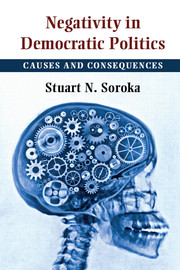Book contents
7 - Negativity in Political Institutions
Published online by Cambridge University Press: 05 June 2014
Summary
To kill an error is as good a service as, and sometimes even better than, the establishing of a new truth or fact.
– Charles DarwinPreceding chapters have outlined and added to an accumulating body of evidence that negative information plays a particularly significant role in political behavior and political communication. It follows that everyday politics can seem overwhelmingly negative. This is a product not just of the nature of people, but of the nature of institutions designed by people.
We have already seen some evidence of this in the preceding discussion of mass media. Media content is biased toward the negative not just because media consumers (and producers) are more attentive to negative information, but because news media were designed, at least where their role as a political institution is concerned, to monitor error. Indeed, it seems reasonable to argue that monitoring error is the central function of media in a representative democracy. This is the crux of the conception of media as a Fourth Estate, after all – as an institution, independent of both business and government, able (and obliged) to hold each to account.
- Type
- Chapter
- Information
- Negativity in Democratic PoliticsCauses and Consequences, pp. 108 - 122Publisher: Cambridge University PressPrint publication year: 2014

